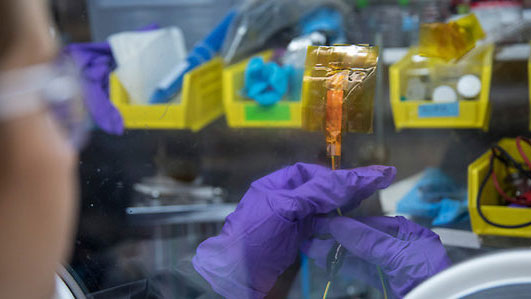Your shirt could one day be a self-powering fitness tracker or VR controller

A team of US scientists has created a device that can harvest electrical charge from human movement, opening up the possibility of using our clothes as chargers for our electrical devices.
The device has been created by scientists from Vanderbilt University’s Nanomaterials and Energy Devices Laboratory, using a filament of black phosphorus only a few atoms thick that creates electrical charge when bent or pressed. So every time you sit down or stand up and your clothes bend, you could be creating electrical current.
The process of generating electrical charge from motion isn’t a new idea, but the frequency of motion that these materials – known as piezoelectric materials – operate best at are above 100 Hertz.
To put that into the context of human movement, one of the students behind this new development said: “When you look at Usain Bolt you see the fastest man on Earth. When I look at him, I see a machine working at 5 Hertz”.
Now obviously, most of us don’t move at anywhere near that speed, but the black phosphorus nanosheets are apparently capable of generating energy at the speeds us mere mortals move at.
How's my form?
Before you start thinking that this is the solution to your smartphone battery always running down, the amounts of voltage being created by this device at present are very small. The team thinks that at present a full shirt would be able to generate enough current to power a small LCD display.
In the future, the team does see the possibility of potential applications in clothing that requires an electrical charge. A T-shirt that changes color is one possible option, but the idea we find most interesting is a self-powering tracking device.
Sign up for breaking news, reviews, opinion, top tech deals, and more.
The professor who led the team, Cary Pint, said: “When incorporated into clothing, our device can translate human motion into an electrical signal with high sensitivity that could provide a historical record of our movements.” So the device could be both the charger and the tracker.
If an item of clothing is able to accurately measure and transmit your physical positioning, it could work as a fitness tracker, measuring your physical output and form. The same technology could also be applied to motion tracking in a virtual reality environment, allowing you to have a physical body in a virtual environment, and use your body as a controller.
The paper, titled ‘Ultralow Frequency Electrochemical Mechanical Strain Energy Harvester using 2D Black Phosphorus Nanosheets’ was published online in scientific publication ACS Energy Letters.
As it’s still at the stage of being a scientific research paper we’re a long way from seeing this technology in our own clothes, but if we hear more about this development we’ll let you know.
- Want to see how your phone could one day not need a battery? Check out: This phone needs no battery
Image credit: John Russel / Vanderbilt University

Andrew London is a writer at Velocity Partners. Prior to Velocity Partners, he was a staff writer at Future plc.